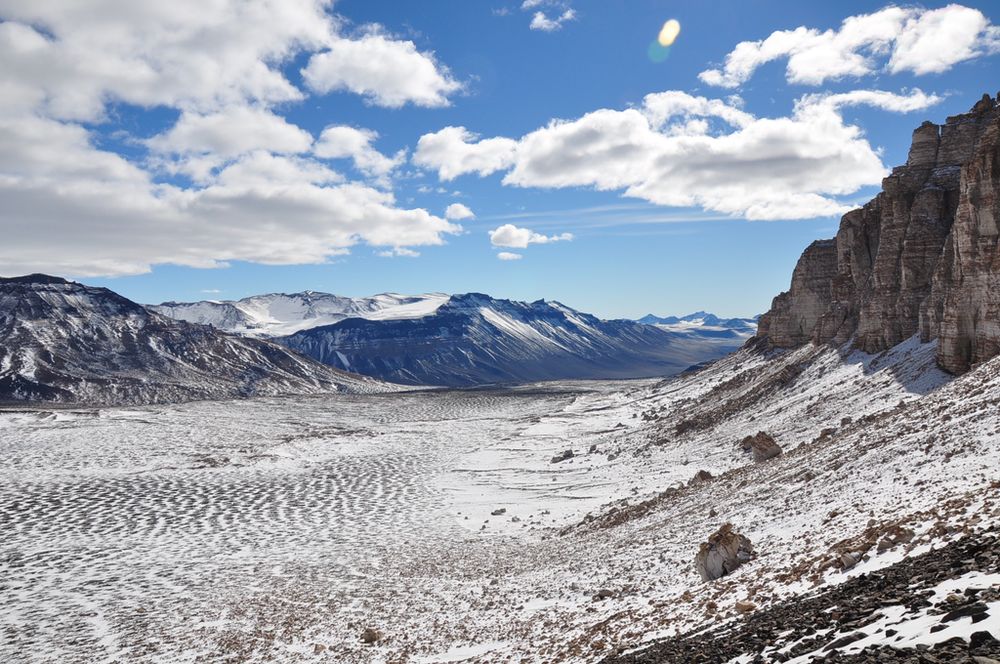Antarctica is one of the most inhospitable places in this earth, with all-year-round freezing temperatures, violent katabatic winds and ice that covers almost the entire continent. But there are regions where the southernmost continent is free of ice cover. These regions are termed “oases” or “dry valleys” because of the comparatively favorable conditions that prevail here for the development of life. Their areas range from several dozen to several thousand square kilometers. Here are some of the most notable Antarctic oases.
McMurdo Dry Valleys

McMurdo Dry Valleys. Photo: Miers Valley/Cool Antarctica

Wall Valley, Antarctica. Photo: Nemadude/Wikimedia
Despite being an “oasis”, the McMurdo Dry Valleys is essentially a desert. No living organism can survive in the permafrost, although some hardy photosynthetic bacteria have been found living in the relatively moist interior of rocks, and anaerobic bacteria, with a metabolism based on iron and sulfur, live under the Taylor Glacier. The McMurdo Dry Valleys contain several extremely saline lakes and a few meltwater rivers.
Cape Hallett

Mount Herschel in the Admiralty Mountains as seen from Cape Hallett. Photo: Andrew Mandemaker/Wikimedia
Cape Hallett is another oasis located on the northern tip of the Hallett Peninsula on the Ross Sea coast of Victoria Land, East Antarctica. Unlike the McMurdo Dry Valleys, Cape Hallett is extraordinarily rich and diverse in plant lives, with 18 species of lichens and five species of mosses. Animals found at the site include, as well as four species of mites and three of springtails, breeding colonies of south polar skuas and Adélie penguins.
Bunger Hills
Bunger Hills, located on the Knox Coast in Wilkes Land in Antarctica, remain notably ice free throughout the year, although exactly how scientists are not sure. The ice-free area measures 450 square kilometer but can be as large as 900 square km, with many freshwater and salt lakes within these rugged hills. The largest and deepest lake, Algae Lake (Lake Figurnoye) is 25 km long and up to 137 meters deep.
Vestfold Hills

Vestfold Hills, Photo: Peter Schuller/Wikimedia
The Vestfold Hills are a series of low-lying, snow and ice-free, rocky, coastal hills, 411 square kilometers in extent, on the north side of Sorsdal Glacier on the Ingrid Christensen Coast of Princess Elizabeth Land, Antarctica. They contain a great variety of lake systems with over 300 lakes and ponds including what is possibly the largest concentration of stratified lakes in the world.
Schirmacher Oasis

Research stations at Schirmacher Oasis. Photo: Solovyanova Irina/Wikimedia
The Schirmacher Oasis is the smallest of Antarctic oases with an area of 34 square km. It is a plateau about 25 km long and up to 3 km wide situated in the Schirmacher Hills on the Princess Astrid Coast in Queen Maud Land in East Antarctica. It contains over 100 freshwater lakes.
Located between the edge of the Antarctic Ice Sheet and the Novolazarevskaya Nivl Ice Shelf, this plateau is about 100 meters high and acts as a barrier to the northwards running ice stream keeping the region ice-free. The relatively warmer temperature allows certain types of mosses and lichens to grow. Animals included the Antarctic skua, the Antarctic petrel, the snow petrel, and the Wilson's storm petrel. Occasionally, Adélie penguins can be seen at the oasis.



Comments
Post a Comment